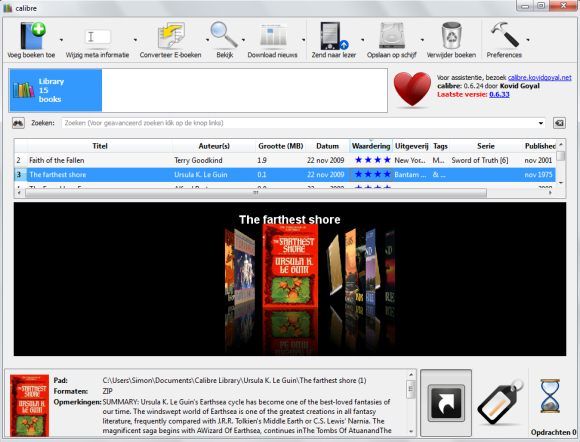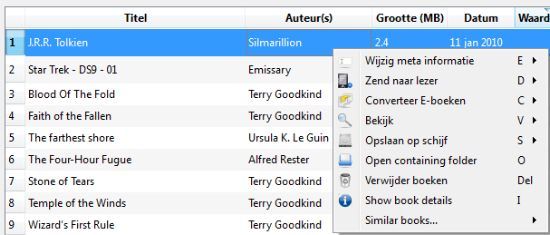eReaders aren't just portable displays to read your eBooks on the go. The difference lies in the display technology.
Where normal displays use liquid crystal-filled pixels, and beam the image on your retina with what is in fact a big flashlight, e-ink technology uses no additional light-source. In fact, they really use an ink-like set-up. The result? No eyestrain at all!
Earlier this week, my own eReader finally arrived; the Sony PRS-300. Five inches of pure bliss. No, not a Kindle. They're not only more expensive, but are less crisp and have added glare thanks to their touchscreen-layer. But don't mind that, of course touchscreen is necessary to read an eBook!
After playing around with the sample books, it was time to fire up the Calibre eBook management software. The default Sony application works like a charm, but its got nowhere near the features of this eBook management suite.
The application is available on Windows, Mac OS X and Linux.
Calibre
Calibre is open source eBook management software. Despite some of its flaws, it's quite possibly the best free eBook solution, even beating most paid applications. You can use it to import and manage your collection, convert between formats, synchronize devices, download RSS news and even retrieve book covers, ISBN information and ratings from the internet.
Even though I've written this article in the spirit of eReaders, Calibre is also compatible with the iPhone Stanza application, and can be used as a local eBook management solution.
Building Your Own Library
You can import single files or entire directories to Calibre. The application will try to determine the book's title and author from the filename. Note the emphasis on 'try', mistakes are often made. As I recall, Silmarillion never wrote J.R.R. Tolkien.
Unless all your books are stored as Title - Author.file, be sure to double-check the imports. If you're uploading a lot of books, you can also adapt the recognition filter in settings.
Once you've got your titles right, you can retrieve additional meta data, like ratings and summaries, as well as a cover. This can be done manually, searching Google Books and isbndb.com for a match (as depicted above), or automatically, for a number of eBooks at once.
Uploading eBooks can take a long time - even more than looking for meta-data. If you've got a big directory to import, best do so overnight. This, together with repeating misclassification, make up the flaws of Calibre.
Conversion
Even if you don't plan on keeping an eBook collection, Calibre is an excellent tool for file conversion. EPUB, FB2, LIT, LRF, MOBI, PDB, PDF, PMLZ, RB, RTF, TCR and TXT are all available formats.
The Calibre eBook management software will try to retain the (now correct) eBook information, as well as the book cover. Depending on the output format, you can tweak the appearance (font size, text justification), auto-detect chapters, and generate a Table of Contents. For use in conjunction with eReaders, there are over a dozen default output formats.
This, of course, does not conclude all there is to Calibre. More advanced users are only getting started. After tweaking the application to match your eReader, you can set up several RSS feeds to be automatically converted to eBooks, as well as setting up a content server to access your books from afar.
What eBook management application do you use? Let us know in the comments!





